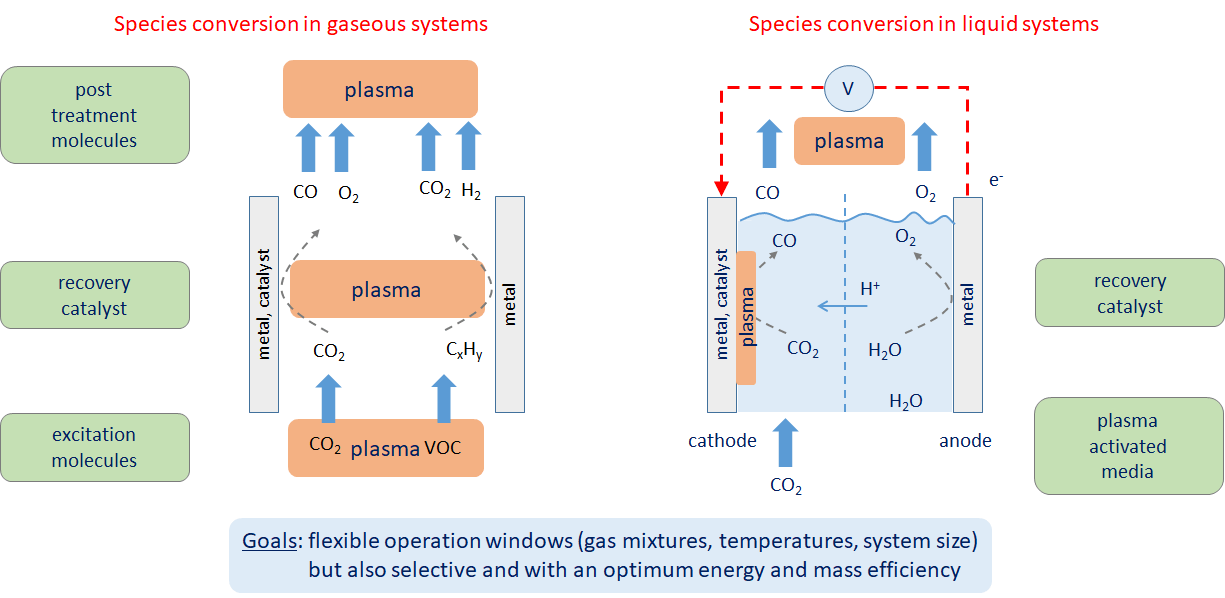General Questions
Non-equilibrium processes are the basis of a multitude of phenomena in nature such as transport, excitation of atoms and molecules and de-excitation and dissipation at surfaces. The non-equilibrium character of plasmas is especially pronounced due to the high energy density in these systems and the very selective excitation of, for example, only the electrons. If these plasmas are brought into contact with solids or liquids, the non-equilibrium character can be transferred to other states of matter. An excellent example are plasma chemistry processes that are directly coupled to catalytically active surfaces.
The use of non-equilibrium atmospheric pressure plasmas is most interesting since they can most easily be combined with standard chemical processes. The non-equilibrium character of these plasmas can be controlled by large gas flows or by short pulsed excitation assuring strong cooling mechanisms. Thereby, a huge variety of desired plasma chemistries or emission patterns can be adjusted following an empirical strategy. However, any further progress is hampered by the lack of a fundamental understanding of those discharges and their interaction with fluid and solid interfaces leading to many open questions:
- How to reach and maintain a stable atmospheric pressure non-equilibrium discharge in a range of different gas mixtures?
- How to efficiently transport the species from the plasma to the object to be treated or coated?
- What are the chemical non-equilibrium synthesis routes of new materials or species?
- How does the transfer of species and energy occur on the nanosecond timescale?
- What are the roles of gaseous, liquid, biological, and solid state catalysts in contact with those plasmas?

The Collaborative Research Centre (CRC) 1316 “Transient atmospheric plasmas – from plasmas to liquids to solids” addresses these research questions by combining expertise in plasma physics, surface physics, chemistry, biotechnology, and engineering. This CRC focuses on transient atmospheric plasmas at varying spatial and temporal scales for the nanostructuring and activation of catalytic surfaces, for the coupling to catalysis and biocatalysis, as well as for electrochemical processes. Due to the strong interaction between these plasmas and the confining interfaces, special in-situ, real-time, and in-operando methods will be employed. The research program follows three consecutive phases with reaching a basic understanding at the beginning to the optimum integration of plasma and active surface, until the up-scaling of these plasmas. The CRC 1316 seeks optimal solutions for systems for energy conversion (solar fuels, CO2 harvesting, photocatalysis), to health (removal of volatile organic compounds from air streams), for biotechnology (plasma-driven biocatalysis), and for technical chemistry (bottom-up synthesis from small molecules to valuable chemicals).
Projects of the CRC1316
-
A1:
Sub-ns electric field measurement in transient atmospheric pressure plasmas
U. Czarnetzki, N. Lepikhin
-
A2:
Ro-vibrational distribution measurement in transient discharges by coherent anti-Stokes Raman scattering
U. Czarnetzki, D. Luggenhölscher
-
A3:
Excitation transfer between molecules in transient atmospheric pressure plasmas and its impact on plasma chemistry
A. von Keudell, D. Reiser
-
A4:
Process control in micro atmospheric pressure RF plasma jets by voltage waveform tailoring and customised boundary surfaces
J. Schulze, T. Mussenbrock
-
A5:
From ns- to ms-pulses – influence of voltage characteristics on surface barrier discharges
I. Korolov. T. Mussenbrock
-
A6:
Pulsed plasma interaction with catalytic surfaces within micro-structured array devices
J. Golda, M. Böke
-
A7:
Plasma catalysis for conversion of volatile organic compounds (VOC)
I. Korolov, M. Muhler, P. Awakowicz
-
A8:
A 1.5 dimensional transient transport model of plasma jets
R.P. Brinkmann
-
A9:
A kinetic chemistry model for atmospheric pressure plasmas
R.P. Brinkmann
-
B1:
Plasma induced nano-structuring for catalyst activation under operando conditions
B. Roldan
-
B2:
Self-organisation of sub-micrometer surface structures stimulated by microplasma generated reactive species and short-pulsed laser irradiation
M. Böke, J. Golda
-
B4:
Theoretical studies on the interaction of excited species with catalyst surfaces
T. Jacob
-
B5:
2D-plasma-liquid-solid interfaces – plasma electrolytic oxidation
A. Gibson, P. Awakowicz
-
B7:
Reaction chemistry of plasmas in liquids interacting with surfaces
A. von Keudell
-
B8:
Non-thermal plasma-driven biocatalysis
J. Bandow, Ch. Jung
-
B11:
Rational tuning of plasma and liquid chemistry for biocatalysis
J. Bandow, J. Golda, A. Gibson
-
B12:
Impact of plasma in liquid on electrodestructure and solution properties
A. Engstfeld, T. Jacob
-
B13:
Plasma-derived nanocatalysts forelectrochemical hydrogen evolution
K. Tschulik
-
B14:
The solvated Electron at the electrified solid/liquid interface: structure and dynamics from ab initio molecular dynamics simulations
M. Sulpizi
-
B15:
Plasma-modified ferroelectric catalysts for the plasma-assisted conversion of volatile organic compounds
B. Mei
-
INF:
Information Infrastructure
M. Prenzel, A. von Keudell
-
MGK:
Integrated Research Training Group
A. von Keudell, M. Muhler
-
PR:
Public Outreach
M. Prenzel

